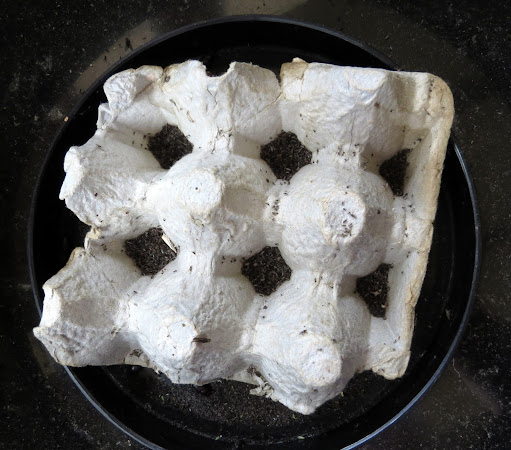Thursday, August 6
The moth trap was heaving this morning, after a warm night. Not necessarily with moths. The centre egg box was full of black midges
The bottom of the trap was a scurry of small black beetles. This potful (17) was a quarter of the ones I caught, so that they could be released in the garden.
The moths included three of our first of the year Lempke's Gold Spot,
Gold Spot, 40 Large Yellow Underwings, 20 Antler Moths, 14 Common Footmen, 17 Dark Arches, 1 Muslin Footman, 1 Rosy Footman. 2 Dun-bars, Straw Dot, 2 Ruby Tigers, 2 Burnished Brass, 1 Poplar Hawkmoth, 1 Scalloped Oak, 1 Silver Y, Smoky and Common Wainscot.
3 Ear moths, 2 of the white variety, 1 brown.
We explored the Dales to-day. North on the A65 as far as Ingleton
Ingleton nestles in the foothills of Ingleborough, one of Yorkshire's famous Three Peaks. The village is surrounded by magnificent limestone countryside with deep caves, spectacular waterfalls and important geological and archaeological sites. Above ground, glaciation has produced scars, erratics, limestone pavement, high cliffs and deep dry gorges. Below ground, the limestone is riddled with dramatic underground rivers and stunning potholes.
We enjoyed the scenery on the drive through Ribblesdale to Hawes in Wensleydale, before taking the Askrigg road to Muker.in Swaledale.
Barren moors, tumbling brown-water rivers, drystone walls and splendid barns.
The occasional corvid and Kestrel, otherwise birdless. We did take a narrow lane down towards the Ribble, with a small patch of deciduous woodland where we heard a family of Nuthatches.
All possible stopping places - there were few - held empty parked cars. Walkers we assume. The two large villages through which we passed, were heaving with people and parked cars. Full cafes and pubs, meandering tourists and lycra clad cyclists. Only to be expected in high season, and good for local trade.
We turned off the main path towards Muker and found somewhere to stop and have a late lunch. Earlier a camo clad man, rifle strapped to the handlebars of his quad bike, had roared past in the opposite direction. He returned, drove up behind us - and skidded off. Gamekeeper? Couldn't find any harriers to shoot in this area known for prosecution of raptors?
On the way home, we were able to stop and view the Ribble Viaduct.
NENTA (North East Norfolk Train Association) used to organise steam train trips beginning in North Walsham. We did seveal with Pam's aged mother, for whom it was ideal. On one trip to Edinburgh, we crossed the Ribble viaduct on a specially arranged steam train.
Further along the road, we realised that there was a better view from the other side - and a largish potholed pull off where we could park. Pam turned round and we parked. As luck would have it, a goods train appeared.
We pass a horse field on the way up to our cottage. A pony with a tremendously long tail, and a Shetland, are never far from each other.
There is also a bank of Whinberries along a drystone wall. Unfortunately, the berries are still red. Mam always had to make Dad one Whinberry tart every year. Not nice raw, not as tart as Blackcurrants, but more astringent.
I'm longing to photograph the swathes of Meadowsweet, banks of Rosebay Willowherb, patches of sungold Golden Rod species and the deep yellow, and rich looking, patches of Ragwort, which adorn the roadside. There's never anywhere to stop.
I did manage a head of Yarrow to-day. Pam had noticed the insect on it. It was only when I edited the photo to-night that we noticed the little hopper type insect also present.













No comments:
Post a Comment